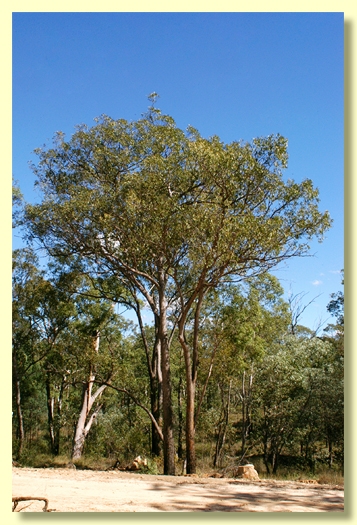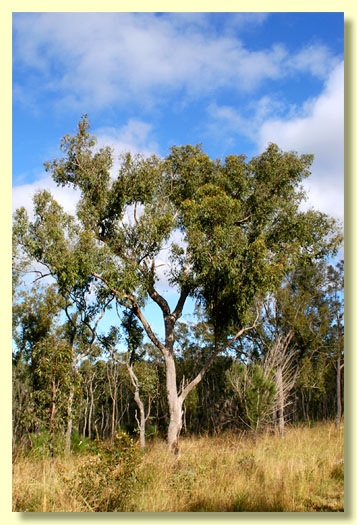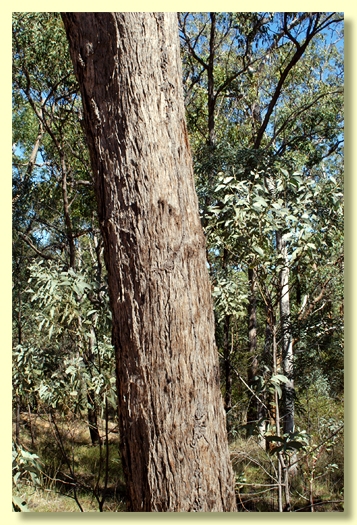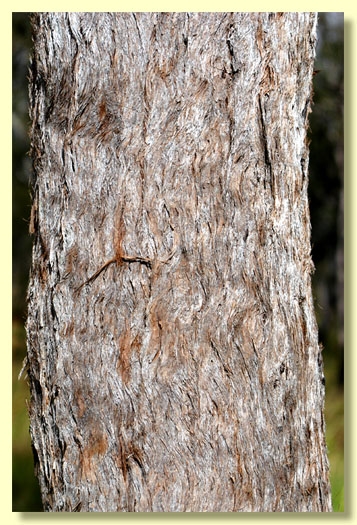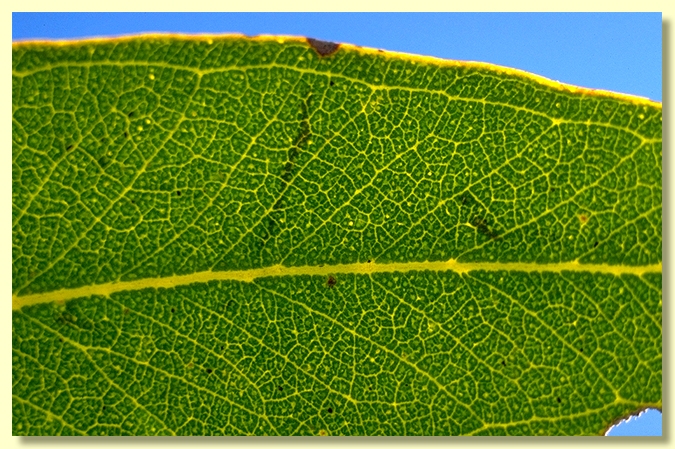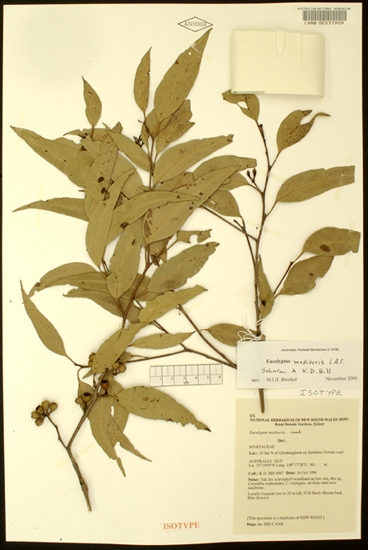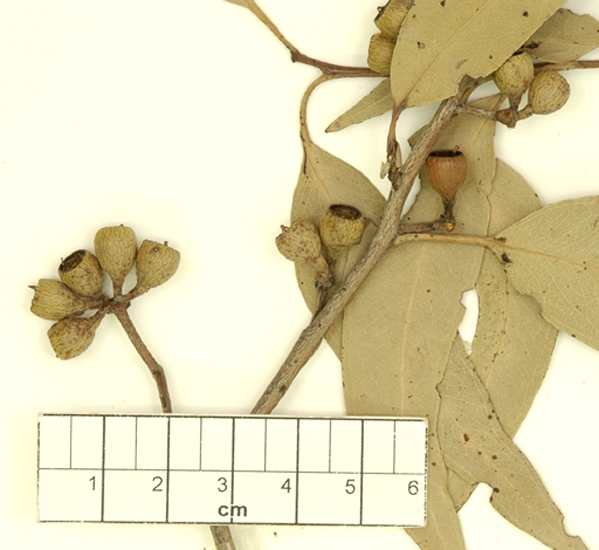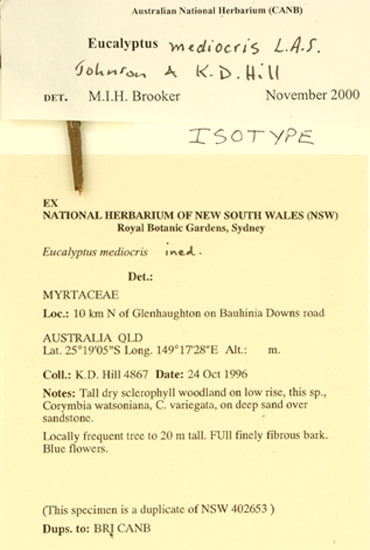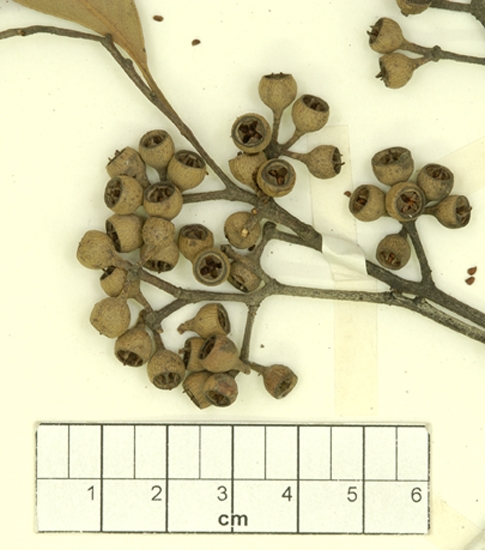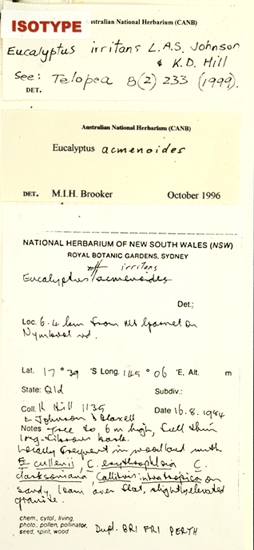Euclid - Online edition
Eucalyptus mediocris
Eucalyptus | Eucalyptus | Amentum
Tree to about 20 m tall. Forming a lignotuber.
Bark rough throughout, grey or grey-brown to yellowish grey or orange-brown-grey, fibrous, sometimes prickly to touch, held on trunk in flattish strips rather than like typical stringybark.
Juvenile growth (coppice or field seedlings to 50 cm): stem rounded in cross-section; juvenile leaves opposite and sessile for some pairs then shortly petiolate, ovate to lanceolate, 6–13 cm long, 1–5.3 cm wide, discolorous, green above, paler green below.
Adult leaves alternate, petiole 0.8–2.3 cm long; blade lanceolate to falcate, 6–17 cm long, 1–2.5 cm wide, base oblique or tapering evenly to petiole, margin entire, concolorous or only slightly discolorous, semi-glossy to very glossy, green, side-veins at ca 45° to midrib, densely reticulate, intramarginal vein obvious, oil glands island and intersectional.
Inflorescence axillary unbranched but often clustered towards the ends of branches and may appear to be terminal and branched, peduncles 0.6–2 cm long, buds 9 or 11 (?or more) per umbel, pedicels 0.2–0.7 cm long. Mature buds ovoid to obovoid, 0.7–0.8 cm long, 0.3–0.4 cm wide, green to yellow, scar absent, the single operculum shedding at flowering, operculum beaked, stamens irregularly flexed, anthers reniform to cordate, versatile, dorsifixed, dehiscing by confluent slits, style long and straight or a bit corkscrewed, locules 3 or 4, the placentae each with 2 vertical ovule rows. Flowers creamy white.
Fruit on pedicel 0.2–0.5 cm long, truncate-globose to hemispherical or cupular, 0.5–0.8 cm long, 0.5–1 cm wide, disc ± level or descending obliquely to vertically or concealed, valves 3 or 4, usually near rim level.
Seeds brown, 1.5–2.5 mm long, pyramidal or obliquely pyramidal, dorsal surface smooth, hilum terminal.
Cultivated seedlings (measured at ca node 10): cotyledons reniform; stems rounded in cross-section; leaves opposite and sessile for at least 10 nodes, ovate to lanceolate, 10–14.5 cm long, 2–4.5 cm wide, base rounded, discolorous, green.
Flowering has been recorded in July and October.
A forest or woodland tree widespread in central Queensland extending from the southern foothills of the Carnarvon Range northwards through Expedition Range, Blackdown Tableland, White Mountains, mountains just west of Townsville and Paluma, to Herberton and the Atherton Tableland and country immediately to the north of there. Preferred habitat is sandstone hills and ridges with poor sandy soil. Eucalyptus mediocris has fully rough finely fibrous more or less matted bark that can be prickly, green more or less glossy adult leaves with densely reticulate venation, beaked buds and predominantly hemispherical to truncate-globose fruit. The juvenile leaves are opposite, sessile or shortly petiolate and ovate-lanceolate for at least 0.5 m of growth.
Within its natural range E. mediocris can be easily distinguished by its rough bark type from all other eucalypts except stringybark species. The adult leaves of any stringybark species have sparsely reticulate venation and a quick inspection of fresh adult leaves against strong sunlight will be informative. In addition stringybarks have furrowed bark with much longer "stringy" fibres, thicker-walled fruit with prominent disc and juvenile leaves that are scabrid/hairy at the lower nodes at least.
There are other species of white mahogany occurring within or adjacent to the natural range of E. mediocris. The widespread tall tree E. acmenoides occurs in wetter forests within this range, occurring on Mt Bogantungan, Blackdown Tableland and in ranges and foothills along the Queensland coast. E. acmenoides differs from E. mediocris mainly in its much thinner-textured adult leaves that are always distinctly discolorous, i.e. are much paler on the underside than the upperside (even when dried out). To the south of the range of E. mediocris another inland-dwelling white mahogany species, E. apothalassica, is found from Yetman in New South Wales north to Inglewood, Eidsvold, Yarraman and Barakula State Forest near Chinchilla and Miles. E. apothalassica differs from E. mediocris only in having smaller fruit (but even fruit dimensions overlap), being 0.3–0.6 cm long and 0.4–0.7 cm wide respectively.
In EUCLID we have included Eucalyptus irritans (see Hill 1999) in synonymy with E. mediocris as the type specimens are virtually identical and there are no consistent morphological differences between numerous herbarium specimens of the two. It could be that the two inland white mahogany species accepted in EUCLID, E. mediocris and E. apothalassica, are only one taxon but this requires further study.
Eucalyptus mediocris: from the Latin mediocris, meaning middling, referring to the medium-sized tree habit of this species.

